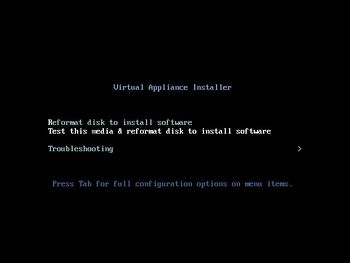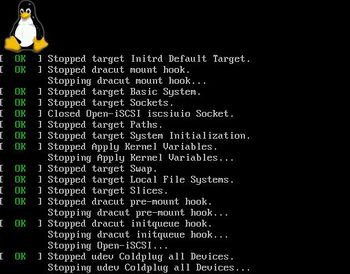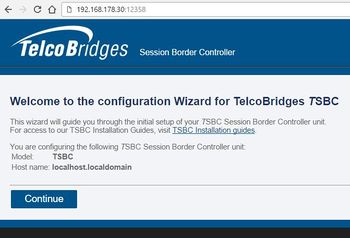FreeSBC:Baremetal:Installation A
Cboulanger (Talk | contribs) m (Used email URL) |
Cboulanger (Talk | contribs) m (Added a few precisions) |
||
| Line 16: | Line 16: | ||
== Installing using the ISO == | == Installing using the ISO == | ||
| − | The ISO installation process will reformat the server's | + | The ISO installation process will <u>reformat</u> the server's disks and install all the necessary software. |
=== Physical installation steps === | === Physical installation steps === | ||
| + | # Physically connect at least one Ethernet interface of the server onto a network from which you have access to an Internet Browser. | ||
# Burn the ISO onto a DVD | # Burn the ISO onto a DVD | ||
| + | # Get an access to the console of the server. Usually, this is achieved by connecting a keyboard and screen to the server. | ||
# Insert the DVD in the optical drive of your server and boot from the DVD drive. | # Insert the DVD in the optical drive of your server and boot from the DVD drive. | ||
# You should get the to the "Virtual Appliance Installer" menu on your display: <br /> [[File:ISO_install_prompt.jpg|350px]] | # You should get the to the "Virtual Appliance Installer" menu on your display: <br /> [[File:ISO_install_prompt.jpg|350px]] | ||
| Line 37: | Line 39: | ||
=== Assigning IP address === | === Assigning IP address === | ||
| + | By default, all detect network interfaces will have DHCP enabled. Thus, the server might already have an IP address assigned if the network has a DHCP server running. In such case, you can display and use it to access the web portal configuration panel. | ||
| + | |||
| + | # Retrieve an IP address assigned by DHCP | ||
| + | # ifconfig | ||
| + | |||
| + | If there is no IP assigned, you will need to configure one manually. | ||
| + | |||
# Assign a IP address to the Ethernet interface having network connectivity. Example if the NIC's name would be eth0: | # Assign a IP address to the Ethernet interface having network connectivity. Example if the NIC's name would be eth0: | ||
# ip link set eth0 up | # ip link set eth0 up | ||
Revision as of 12:14, 20 April 2017
Contents |
Requirements
Minimal server requirements:
- Quad core Intel CPU 2GHz
- Optical disk driver
- 80G hard drive
- 8G RAM
- DPDK supported NICs (http://dpdk.org/doc/nics)
- Console access through serial port or keyboard/monitor ports
For better performance (see optimization section)
- NUMA tunning
- PCIe tunning
Getting the ISO
Please contact our sales team to get a copy of the latest TBSC-SW ISO.
Installing using the ISO
The ISO installation process will reformat the server's disks and install all the necessary software.
Physical installation steps
- Physically connect at least one Ethernet interface of the server onto a network from which you have access to an Internet Browser.
- Burn the ISO onto a DVD
- Get an access to the console of the server. Usually, this is achieved by connecting a keyboard and screen to the server.
- Insert the DVD in the optical drive of your server and boot from the DVD drive.
- You should get the to the "Virtual Appliance Installer" menu on your display:

- Hit 'R' key, then 'ENTER' key to start the installation

- Wait for the installation process to complete. When installation is complete, the server will reboot itself.
- Important: Make sure to remove the DVD from the drive while the server is rebooting. If you get back to "Virtual Appliance Installer", just eject the CD and reboot again.
Changing the root password
- Use the console to login into the server
- user: root
- password: root
- Change the password to something stronger than root:
# passwd New password: ........ Retype new password: ........ passwd: all authentication tokens updated successfully.
Assigning IP address
By default, all detect network interfaces will have DHCP enabled. Thus, the server might already have an IP address assigned if the network has a DHCP server running. In such case, you can display and use it to access the web portal configuration panel.
- Retrieve an IP address assigned by DHCP
# ifconfig
If there is no IP assigned, you will need to configure one manually.
- Assign a IP address to the Ethernet interface having network connectivity. Example if the NIC's name would be eth0:
# ip link set eth0 up # ip addresss add 192.168.178.30/24 dev eth0
Accessing the TSBC-SW web portal
- Open a web browser to the IP of your server, on port 12358. Example if your server address is 192.168.178.30, the URL would be:
http://192.168.178.30:12358 - You should get to the TSBC Configuration Wizard

From here, you can go to Web Portal Initial Configuration Guide to continue the installation, and/or optimize your server to get the maximum out of your server.
Web Portal Initial Configuration
Click on the following link to pursue installation from the web portal: TSBC-SW:WebPortal:Initial Configuration
Optimizations
Click on the following link for baremetal server optimizations: TSBC-SW:Baremetal:Optimizations